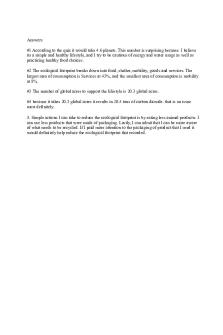Ecological Footprint Activity PDF

| Title | Ecological Footprint Activity |
|---|---|
| Author | Evan Le |
| Course | Introduction To Environmental Science |
| Institution | Valencia College |
| Pages | 3 |
| File Size | 90 KB |
| File Type | |
| Total Downloads | 8 |
| Total Views | 175 |
Summary
Calculate ecological footprint activity ...
Description
Tran Le Josh Castro EVR 1001 September 2, 2020
Ecological Footprint Activity Your Ecological Footprint 1. How many planet Earths? -
5.8 planet Earths
2. How many global hectares of Earth’s production area? -
9.9 global hectares of Earth’s production area
Percentage as carbon footprint: 62% 3. Breakdown of your ecological footprint: a. Food: 2.7 gha b. Shelter: 0.1 gha c. Mobility: 3.8 gha d. Goods: 1.7 gha e. Services: 1.6 gha
Strategies for Sustainability
4. What are 3 ways you can realistically lessen your ecological footprint and achieve a sustainable development?
- Eat less meat: One of the best way for me to reduce my ecological footprint is enjoying vegetarian-friendly meal days and supporting local meat sources.
- Reduce my waste: I’d better reduce packaging waste in the kitchen by buying bulk, eating a more vegetables. Moreover, reduce my bathroom product waste by making
my own formulas, buying reusable stuffs. Beside that, always remember to recycle plastic bottles, toilet paper rolls…
- Drive less: Anytime, I should take a chance to travel without a car. Whenever I have to drive in a short distance, I’d better consider taking public transit or driving bike.
Comparison of Countries 5. Compare the ecological footprint, biocapacity, and ecological reserve/deficit of the United States, Argentina, and Indonesia. Answer in terms of the number and trends through time, as well as predict why these trends are happening. You can look at other figures such as table at the bottom for increases and decreases in the different categories or figures in this map. a. United States The United States of America has a very high ecological footprint at 8.1 gha per person in 2016, although it was much higher at 10.1 in the last ten years.. The data shows the decrease in the biocapacity per person from 3.6 gha in 1961 to 3.6 gha in 2016. Thus, this puts America in a biological deficit. b. Argentina Argentina had a very high biocapacity per person at 6.8 gha in 2016, surprisingly; Argentina’s biocapacity per person in 1962 was much higher at 10.1 gha. Because of that, Argentina has obviously decreased biocapacity dramatically. Moreover, Argentina’s ecological footprint per person in 2016 was 3.5 gha. Somehow, in 1974, Argentina had a very high ecological footprint per person at 4.6 gha. However, Argentina still has kept its biocapacity reserve since 1961. c. Indonesia Indonesia had much low ecological footprint at 1.7 gha in 2016. According to Global Footprint Network, Indonesia’s ecological footprint has always been around 1.5 gha to 1.7 gha. Moreover, Indonesia’s biocapacity per person was 1.3 gha in 2016, it has been decreased dramatically from 2.8 gha to 1.3 gha since
1961. Indonesia had a biocapacity deficit from -0.0 gha to -0.4 gha since 2000. Before 2000, Indonesia had a biocapacity reserve d. Comparison of 3 countries According to Global Footprint Network Advancing the Science of Sustainability, the United States of America has more ecological footprint (gha per person ) than Argentina and Indonesia, America is one of the highest ecological footprint in the world, because Americans are using twice the renewable natural resources, and creating more carbon dioxide than can be absorbed in the atmosphere. Moreover, about the biocapacity (gha per person); Argentina has a higher biocapacity than America and Indonesia, Argentina is a country of abundant natural resource, and also has one of the strongest economies in Latin America, because of that: Argentina’s biocapacity footprint is no surprisingly higher than the other two countries, while Argentina is being in an ecological reserve, it shows that they are using less resources than they actually have. About Indonesia, the result of the ecological footprint study of Indonesia shows in general that they are still using relatively less natural resources than its potential. It’s obviously shown by the high level of biocapacity to the lower level of ecological footprint, thus; the biocapacity of Indonesia is still in reserved condition...
Similar Free PDFs

Ecological Footprint Activity
- 3 Pages

Ecological footprint
- 1 Pages

Ecological Footprint Worksheet
- 2 Pages

A11.1 Carbon Footprint
- 1 Pages

Ecological Succession
- 4 Pages

Ecological Succession
- 5 Pages

23 Ecological Relationships-S
- 8 Pages

Ecological succession lab
- 5 Pages

AGRO ECOLOGICAL REGIONS OF INDIA
- 5 Pages

Ecological theories of crime
- 4 Pages
Popular Institutions
- Tinajero National High School - Annex
- Politeknik Caltex Riau
- Yokohama City University
- SGT University
- University of Al-Qadisiyah
- Divine Word College of Vigan
- Techniek College Rotterdam
- Universidade de Santiago
- Universiti Teknologi MARA Cawangan Johor Kampus Pasir Gudang
- Poltekkes Kemenkes Yogyakarta
- Baguio City National High School
- Colegio san marcos
- preparatoria uno
- Centro de Bachillerato Tecnológico Industrial y de Servicios No. 107
- Dalian Maritime University
- Quang Trung Secondary School
- Colegio Tecnológico en Informática
- Corporación Regional de Educación Superior
- Grupo CEDVA
- Dar Al Uloom University
- Centro de Estudios Preuniversitarios de la Universidad Nacional de Ingeniería
- 上智大学
- Aakash International School, Nuna Majara
- San Felipe Neri Catholic School
- Kang Chiao International School - New Taipei City
- Misamis Occidental National High School
- Institución Educativa Escuela Normal Juan Ladrilleros
- Kolehiyo ng Pantukan
- Batanes State College
- Instituto Continental
- Sekolah Menengah Kejuruan Kesehatan Kaltara (Tarakan)
- Colegio de La Inmaculada Concepcion - Cebu





